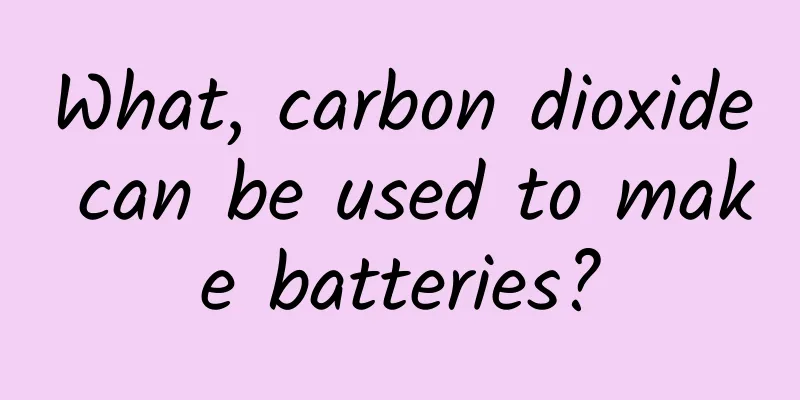What, carbon dioxide can be used to make batteries?

|
Produced by: Science Popularization China Author: Tan Peng and Zhang Zhuojun (University of Science and Technology of China) Producer: China Science Expo In recent years, as lithium-ion battery technology has gradually matured, electric cars can be seen everywhere on the road. The range of electric cars has always been a key indicator of people's attention, which is directly determined by the storage capacity of the lithium-ion batteries they carry. The electric vehicle industry is booming (Photo source: Veer Gallery) We usually use the concept of energy density to evaluate the ability of a battery to store electricity. There is a battery whose energy density is more than 7 times that of a lithium-ion battery. When discharging, it uses carbon dioxide as fuel and converts part of the energy in carbon dioxide into electricity for our use. It seems that this magical battery can not only release more "electrical energy", but also "recycle" carbon dioxide, the culprit of the greenhouse effect, and actively respond to the "dual carbon" goal, which can be said to kill two birds with one stone. It is the lithium-carbon dioxide battery! Achieving both “energy supply” and “dual carbon” goals (Photo source: Veer Gallery) my country's energy landscape At present, through the continuous reform and development of new and old energy, my country has gradually formed the world's largest energy supply system, and established an energy supply pattern with coal as the main body, electricity as the center, and oil, natural gas and renewable energy as the comprehensive development. Among them, fossil energy occupies a dominant position in my country's energy supply. The burning of fossil fuels results in large amounts of waste gas emissions (Photo source: Veer Gallery) my country attaches great importance to the greenhouse effect caused by large-scale carbon dioxide emissions. In order to achieve the goal of "dual carbon" as soon as possible, a series of policy measures have been formulated around the green and low-carbon development of energy. On the one hand, the use of fossil fuels is reduced, and on the other hand, non-fossil energy is planned to be used to meet basic energy needs. Electrochemical energy storage, as an efficient technical means, has attracted widespread attention from the society. Lithium-CO2 Battery VS Lithium-Ion Battery The structure and working principle of lithium-carbon dioxide batteries are somewhat different from the lithium-ion batteries we are familiar with. The positive electrode material of lithium-ion batteries is usually a lithium-containing compound, and the negative electrode material is graphite. Charging and discharging rely on the embedding and extraction of lithium ions into graphite and lithium-containing compounds. In 1985, Nobel Prize winner in Chemistry Akira Yoshino first produced the first modern secondary lithium-ion battery. In 1991, Sony began mass production of commercial lithium-ion batteries. Commercial lithium-ion battery modules (Photo source: Veer Gallery) At the same time, in order to meet the requirements of using more equipment and under more constraints, lithium battery pioneers such as Tarascon began to study lithium-oxygen batteries. The positive electrode of lithium-oxygen batteries uses a loose and porous conductive medium (usually called a gas positive electrode), and the negative electrode uses metallic lithium. Its working process is: during the discharge process, lithium loses electrons to become lithium ions, which are released from the lithium negative electrode and then diffuse to the positive electrode side; gaseous oxygen dissolves in the electrolyte and then diffuses into the porous electrode, undergoes oxygen reduction reaction at the interface between the electrolyte and the electrode, and combines with lithium ions to produce solid products such as lithium peroxide, which are finally stored in the pores of the positive electrode. During charging, lithium peroxide decomposes and releases oxygen; lithium ions obtain electrons on the surface of the negative electrode and deposit. Schematic diagram of mass transfer and reaction process in lithium oxygen battery (Image source: Tan Peng's research group at the University of Science and Technology of China) Researchers thought, since oxygen can be used as an active substance, can other gases work? The subsequent lithium-carbon dioxide battery was developed on the basis of lithium-oxygen batteries and has a similar structure to lithium-oxygen batteries. The solid products produced by discharge are lithium carbonate and carbon, thus achieving energy supply and carbon fixation at the same time. Schematic diagram of the structure and working principle of lithium-carbon dioxide battery (Image source: Tan Peng's research group at the University of Science and Technology of China) To achieve the purpose of energy storage, it is necessary to achieve secondary electrochemical rechargeability: the charging process of lithium-carbon dioxide batteries is the decomposition process of lithium carbonate and carbon, and the deposition process of lithium. However, if you want the carbon dioxide battery to continuously fix carbon, there is no need to charge it. Lithium carbonate produces carbon dioxide when it decomposes, so the fixed carbon returns to the environment. So how can we realize a non-chargeable lithium-carbon dioxide battery? An ideal method is to make the electrolyte flow. By controlling the reaction process, the flowing electrolyte can take the solid products or intermediate products produced during discharge away from the battery system and store them in a pre-prepared tank. Since the solid products are not stored in the gas positive electrode, there is no need to charge it. This is something that lithium-ion batteries cannot do, which is determined by the reaction principle. It is difficult to replace carbon dioxide. The development of lithium-carbon dioxide batteries is not a smooth journey. Although this battery has a high theoretical energy density, its actual energy density is relatively limited. The calculation method of energy density is very simple: theoretical specific capacity (mAh/g) × theoretical voltage (V). If any one of the items fails to reach the theoretical value, the energy density will be attenuated. In daily life, we are familiar with the inert properties of carbon dioxide. It is a very stable molecule that can be used as the main component in fire extinguishers, or as a protective gas during storage and transportation to reduce oxidation and respiratory consumption of fruits, vegetables and meat. It is precisely because of the stable inert nature of carbon dioxide that although the theoretical voltage of lithium-carbon dioxide batteries is 2.8 V in thermodynamics, the actual discharge voltage loss is very large. Researchers in my group found that the actual voltage of lithium-carbon dioxide batteries is usually around 1.1 V, which makes it difficult to produce high voltages similar to lithium-oxygen batteries (>2.5 V). Lithium-carbon dioxide batteries also face the problem of short service life. As for carbon fixation, although the flow of electrolyte can remove some solid products from the battery system, it still cannot prevent them from depositing on the electrode surface, and the carbon fixation effect will also decay as the electrode gradually passivates. For energy storage, lithium carbonate and carbon are fixed in a solid form in a porous electrode. After the battery is charged, some lithium carbonate is difficult to completely decompose. Over time, the pores inside the electrode will be gradually blocked, causing slow material transfer, and lithium carbonate covers the surface of the air electrode, making it difficult for electrons to conduct, resulting in a higher charging voltage (>4.0 V), causing the electrolyte and electrode materials to decompose. New batteries, new future Although there are many problems, there are always solutions. My research group studied the method of regulating the discharge voltage of lithium-carbon dioxide batteries by decoupling the air components, explaining the reason why its voltage test has been unstable for a long time. The study found that mixing 1% oxygen and 500 ppm (parts per million) of water into carbon dioxide can increase the voltage to about 2.0 V, and the energy density will double. The introduction of oxygen and water changes the generation path of lithium carbonate, thereby reducing the energy barrier; the morphology and crystal form of lithium carbonate also change significantly, alleviating the electrode passivation phenomenon, so the electrode can provide more active sites for reaction and material adsorption, thereby accelerating the electrochemical reaction process. This study repositions the development and application direction of the next generation of lithium-carbon dioxide batteries. In order to realize the application of lithium-carbon dioxide batteries as soon as possible, the following efforts need to be made in scientific research: on the one hand, conduct mechanism research in a pure carbon dioxide environment and develop components (such as catalysts, electrolytes and electrodes) that are truly suitable for carbon dioxide reduction, rather than copying previous research or experience with lithium-oxygen batteries; on the other hand, conduct in-depth research on the reaction mechanism and transmission process in gas-assisted (such as oxygen, water and carbon monoxide) carbon dioxide batteries to reveal the role of auxiliary gases in the system. The use of other gas-assisted research strategies can not only improve battery performance, but also promote the application of lithium-carbon dioxide batteries in more complex gas environments. For example, industrial waste gas contains a large amount of carbon dioxide and other gases, and carbon dioxide batteries can generate electricity while fixing carbon; there is an extremely high concentration of carbon dioxide in the Martian atmosphere, and carbon dioxide can be used as the "fuel" of the Mars rover to output electricity... Mars rover expected to be equipped with gas-assisted carbon dioxide batteries (Photo source: Veer Gallery) Perhaps in the near future, we will be able to see this new battery company demonstrate its prowess in large-scale waste gas treatment or deep space exploration! Conclusion On the road to achieving the "dual carbon" goal, solving the energy problem is one of the most important development directions. The energy storage and carbon fixation properties of lithium-carbon dioxide batteries have enabled them to play an important role in energy issues. In the future, there will be more scientific and technological innovations to help the "dual carbon" goal. We must believe that Chinese scientists have been forging ahead on the road of innovation. Note: The relevant results of this article were completed by postdoctoral fellow Xiao Xu and doctoral student Zhang Zhuojun under the guidance of Professor Tan Peng, and have been published online in the international academic journal Proceedings of the National Academy of Sciences of the United States of America (PNAS). Editor: Sun Chenyu |
<<: Women must do these 10 health checks, especially after the age of 30!
>>: In order to "put more 'Chinese oil' in the oil bottle", she "grinded" for 10 years
Recommend
There are tea trees in the tea garden, so why plant grass?
Do you think there are only tea trees in a tea ga...
Why don’t startups choose to develop Android apps first?
[[153581]] In the mobile application field, espec...
Spending tens of thousands of dollars to bring an observation of fan circle marketing activities
With the continued popularity of many "star-...
How to create an entry in Baidu Encyclopedia? What are the steps to guide Baidu Encyclopedia to create an entry?
Even though Baidu is very rogue and has been refu...
Muxi Reading 1.5.1 A huge amount of resources for you to choose from
【Software Description】 Muxi reading software is a...
3 cents for a Tik Tok follower? In the age of 15 seconds of fame, how can you monetize through TikTok?
Pop art master Andy Warhol said that everyone can...
Android turns into zombie: Analysis of the new virus "Viking Tribe"
Check Point's research team discovered a new ...
I never expected that dry, frizzy, and fluffy hair may be related to this disease...
Reviewer of this article: Zhou Xiaobo, Doctor of ...
With a click-through rate of 6.44%, e-commerce brands leverage WeChat Moments ads to monetize efficiently!
In recent years, with the disappearance of traffi...
APP Operation Tips | App Store "Clear Words" Remediation Guide!
As an APP promotion and operation, keyword covera...
Where does a fart go after you hold it in? Here's the stinkiest science lesson ever
Many people may have had the embarrassing moment ...
Owl blood + wine? In order to treat this disease, humans have been "thinking out of their minds" for thousands of years.
I went through a frustrating inspection some time...
Tesla's domestic production is finalized and will be put into production in 2020
As a huge consumer market for electric vehicles, ...
The latest Douyin live streaming sales skills!
How to set the live broadcast title and cover? Ho...
React Native vs. Kotlin: A Quick Comparison
Mobile applications have become an emerging platf...









